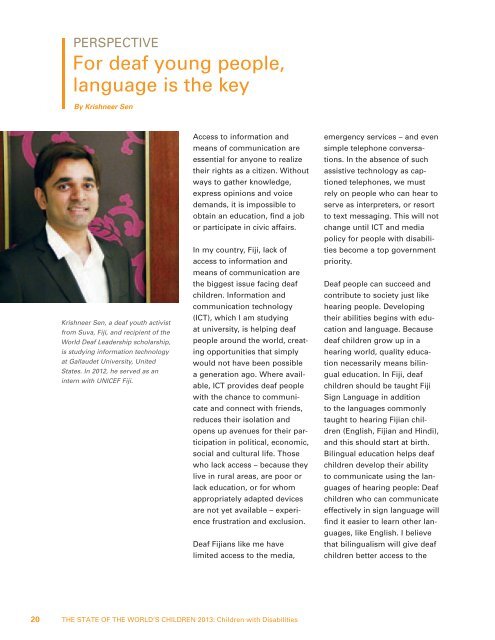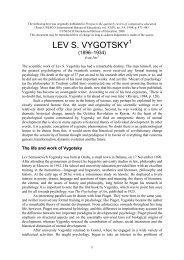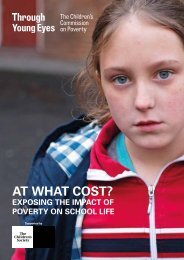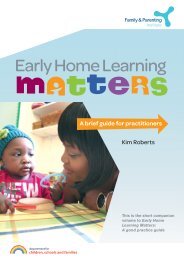Children with Disabilities
Children with Disabilities
Children with Disabilities
You also want an ePaper? Increase the reach of your titles
YUMPU automatically turns print PDFs into web optimized ePapers that Google loves.
20<br />
PERSPECTIVE<br />
For deaf young people,<br />
language is the key<br />
By Krishneer Sen<br />
Krishneer Sen, a deaf youth activist<br />
from Suva, Fiji, and recipient of the<br />
World Deaf Leadership scholarship,<br />
is studying information technology<br />
at Gallaudet University, United<br />
States. In 2012, he served as an<br />
intern <strong>with</strong> UNICEF Fiji.<br />
Access to information and<br />
means of communication are<br />
essential for anyone to realize<br />
their rights as a citizen. Without<br />
ways to gather knowledge,<br />
express opinions and voice<br />
demands, it is impossible to<br />
obtain an education, find a job<br />
or participate in civic affairs.<br />
In my country, Fiji, lack of<br />
access to information and<br />
means of communication are<br />
the biggest issue facing deaf<br />
children. Information and<br />
communication technology<br />
(ICT), which I am studying<br />
at university, is helping deaf<br />
people around the world, creating<br />
opportunities that simply<br />
would not have been possible<br />
a generation ago. Where available,<br />
ICT provides deaf people<br />
<strong>with</strong> the chance to communicate<br />
and connect <strong>with</strong> friends,<br />
reduces their isolation and<br />
opens up avenues for their participation<br />
in political, economic,<br />
social and cultural life. Those<br />
who lack access – because they<br />
live in rural areas, are poor or<br />
lack education, or for whom<br />
appropriately adapted devices<br />
are not yet available – experience<br />
frustration and exclusion.<br />
Deaf Fijians like me have<br />
limited access to the media,<br />
THE STATE OF THE WORLD’S CHILDREN 2013: <strong>Children</strong> <strong>with</strong> <strong>Disabilities</strong><br />
emergency services – and even<br />
simple telephone conversations.<br />
In the absence of such<br />
assistive technology as captioned<br />
telephones, we must<br />
rely on people who can hear to<br />
serve as interpreters, or resort<br />
to text messaging. This will not<br />
change until ICT and media<br />
policy for people <strong>with</strong> disabilities<br />
become a top government<br />
priority.<br />
Deaf people can succeed and<br />
contribute to society just like<br />
hearing people. Developing<br />
their abilities begins <strong>with</strong> education<br />
and language. Because<br />
deaf children grow up in a<br />
hearing world, quality education<br />
necessarily means bilingual<br />
education. In Fiji, deaf<br />
children should be taught Fiji<br />
Sign Language in addition<br />
to the languages commonly<br />
taught to hearing Fijian children<br />
(English, Fijian and Hindi),<br />
and this should start at birth.<br />
Bilingual education helps deaf<br />
children develop their ability<br />
to communicate using the languages<br />
of hearing people: Deaf<br />
children who can communicate<br />
effectively in sign language will<br />
find it easier to learn other languages,<br />
like English. I believe<br />
that bilingualism will give deaf<br />
children better access to the






